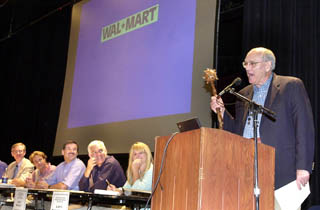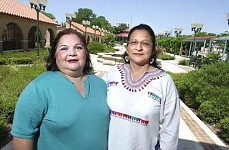Battle of the Big Box
Enviros and Southwest neighbors find a common cause: fighting Wal-Mart
By Lauri Apple, Fri., July 11, 2003

Wal-Mart founder Sam Walton once pledged to stay out of any community where the company wasn't wanted. If that's still true, then the nation's largest retailer and employer might want to reconsider its plans for MoPac and Slaughter Lane. On July 2, more than 500 people -- many of them loudly irate about bargain-shopping taking place in their backyards and over the Edwards Aquifer -- showed up at Bowie High School for a community forum on the Wal-Mart Supercenter planned for a 29-acre tract in the Barton Springs Recharge Zone. Moderating the proceedings was former Mayor Frank Cooksey, wielding a spiky, medieval-looking mace given him by a judge in Estonia. "I don't want to have to use this," he joked.
Originally planned for the Lady Bird Johnson Wildflower Center, the two-hour forum was moved after the center astutely anticipated a much larger crowd than it could accommodate. Panelists included environmental experts, nearby neighbors, and Council Member Daryl Slusher, City Hall's point person on all things Barton Springs. Slusher encouraged the crowd to "vote with [their] wallets" by boycotting stores that don't comply with water quality regulations. While Wal-Mart reps were also on hand to present their side, the forum was more an anti-Wal-Mart sit-down rally than a venue for information sharing. The Supercenter appears to be a done deal, but opponents still hope to convince the company to move the store to another location.
A Kinder, Greener Wal-Mart?
The Wal-Mart site is part of a tract grandfathered in 1996 in a binding agreement, between the city and the tract's then-owner, that requires the city to enforce the less-stringent water quality regulations in effect before the 1992 adoption of the Save Our Springs Ordinance. Those rules permit Wal-Mart to build to an impervious cover level of 65%, four times the amount allowed by SOS. Wal-Mart recently bought the land from local developers Endeavor Real Estate Group, which has drawn fire for promoting the potential for "tremendous growth" over the Edwards Aquifer. Endeavor plans to develop 14 acres around the Wal-Mart site with what will likely be national chains. Slusher didn't hesitate to deem Endeavor a pariah that disrespects community values, comparing the firm unfavorably to Stratus Properties and even Gary Bradley, both of whom, Slusher noted, had agreed to abide by SOS. (Adding injury to insult, the city just approved a $37 million incentive package for The Domain, another Endeavor project.)
Wal-Mart representatives tried to persuade the crowd that they would mitigate the environmental degradation or traffic burden that opponents expect. The company claims that, in addition to limiting impervious cover to 51%, the store will participate in the city's Green Building program; install new water filtration technology and harvest rainwater from the roof; include setbacks to protect critical environmental features and 200 skylights to reduce energy consumption; and use shielded lighting in the parking lot to minimize glow. The store's design will also feature "Hill Country" architecture to distinguish it from Wal-Mart's standard blue, red, and gray cinderblock big box. Meanwhile, Endeavor says it has agreed to spend $720,000 to acquire and preserve acreage elsewhere over the aquifer.
"This is not a one-size-fits-all project," said Daphne Moore, who flew in from Wal-Mart headquarters in Bentonville, Ark., to speak for the company. But it is a gigantic one: If and when it's completed, the store will feature 36 departments, including a full grocery store and deli/bakery. (That's what makes a Supercenter different from a regular Wal-Mart.) It also will provide 400 new jobs, 70% of them full-time, Moore said. And if all that shopping convenience weren't enough, another Supercenter is also being contemplated at I-35 and Slaughter, four miles away.
Though assessing the forum as "well-run," Moore told the Chronicle late last week that forum organizers didn't contact anyone representing Wal-Mart or Endeavor until the eleventh hour. "I don't think there was any interest in what we had to say," she commented. Because of the expected tone of the meeting, and because they have already met with neighborhood groups, Endeavor principals decided not to attend, sending hired spokesman Trey Salinas in their stead. Salinas also serves as spokesman for Longhorn Pipeline Partners, whose controversial pipeline bisects the Wal-Mart tract. "This [forum] was organized and geared to be somewhat of a lashing," Salinas said. "We felt it was best just to go and listen."

While Salinas remained stationed in the audience, Moore -- along with superlawyer Richard Suttle, Wal-Mart's local counsel -- provided ambiguous answers, or no answers at all, to questions raised by the crowd. What Suttle and Moore did say wasn't often what the crowd wanted to hear. Suttle drew hisses for implying that public funds should be used to accommodate the estimated 13,800 vehicle trips and 10 to 15 freight trucks the Supercenter would bring to the area each day. (Though it faces MoPac, the site is not accessible from the expressway -- traffic onto the site would be carried on Slaughter and Davis Lane.)
Details also remain hazy about Endeavor's supposed $720,000 commitment to acquire mitigation land -- how much land, and where, Endeavor intends to buy -- which has stirred further suspicion among the Supercenter's detractors. "Will [they] guarantee that the [proposed filtration] system will not pollute the aquifer, and back it up with bonds and penalties?" asked Save Barton Creek Association President Jon Beall. "Once you ask the developers for guarantees, they equivocate. They do not have the faith in their system to put their money where their mouth is."
"Kumbaya" Is Sung
The high-stakes challenge of the Supercenter has done much to unite local enviros, repairing fractures caused by Smart Growth and the Bradley and Stratus deals. Once again, former SOS Alliance leaders Robin Rather and Brigid Shea, currently board members of Liveable City, are on the same side as current SOS partisans who think (or used to think) that Rather and Shea sold the cause out during the Smart Growth era. (Rather spent the evening seated with green grandes dames Shudde Fath and Mary Arnold.) And Slusher traded friendly quips on the panel with progressive political consultant Mike Blizzard -- who, after working for Slusher on his first three campaigns, jumped ship and backed Slusher's foe Kirk Mitchell in 2002. "We're all one big happy family now," SOS deputy director Brad Rockwell chuckled after Wednesday's meeting. "We all sing 'Kumbaya.'"
While the Wal-Mart has reunited old allies, it has also galvanized residents of Sendera Estates, Circle C Ranch, New Villages at Western Oaks, and other neighborhoods located in the shadow of the Supercenter. The anti-Wal-Mart campaign is mostly being driven by the residents, Rockwell says, leading to some strange bedfellow-making between SOS et al. and Circle C et al. The Southwest neighbors -- who not too long ago were bitterly fighting being annexed by the city -- have now found common cause with Austin and its activist ways. Two-thirds of the more than 570 dues-paying members surveyed by the Circle C Homeowners Association believe that resources should be allocated to fight the Supercenter.
That's not to say the Supercenter lacks support. Circle C resident Lisa Roberts says she's "angry" with HOA leaders for opposing Wal-Mart, who she believes has made "a ton of concessions" to address water quality and traffic issues. Roberts currently drives to the Supercenter in San Marcos to shop and looks forward to the convenience of a closer store. "Those of us who want it don't think we need to protest," she said.
But those who don't want it plan to protest a lot -- and boycott. Sendera resident Lori Erickson, whose neighborhood lies right behind the Wal-Mart tract, made a presentation outlining concerns about traffic, noise and light pollution, stormwater runoff, litter, and disruption caused by the store's 24-hour operation. Regarding Wal-Mart's "concessions," Erickson reminded the crowd of a lawsuit filed against Wal-Mart by the U.S. Environmental Protection Agency in 2001 over stormwater violations at 17 locations, including many in Texas. About Wal-Mart's 24-hour operations, she noted that neighbors "go to bed at midnight and wake up at dawn. We expect a store to do the same thing in our midst." Even the shielded lighting plan seems iffy, she indicated. "Will we be able to see our stars at night?" she wondered.
Despite their differences of opinion, both Erickson and Roberts share one concern: What Wal-Mart will do with its existing store at MoPac and US 290 West. Anticipating high sales, Moore said that once the Supercenter is up and running, the company may expand the existing location or turn it into a Supercenter. Moore appeared unmoved by the crowd's promise of a boycott at MoPac and Slaughter and greeted the audience's pleas to move elsewhere with ambiguity.
But in other cities, Wal-Mart has in fact kept Sam Walton's word and relocated or abandoned store plans in the face of grassroots opposition. With that in mind, panelists spent the final minutes of the forum reviewing "action items" concerned citizens could take to stay informed and make their voices heard. Organizers of the AustinAction Web site (www.noaquiferbigbox.com) are distributing a weekly e-newsletter and conducting a survey on the Supercenter; that site also addresses the likewise controversial Lowe's Home Improvement Warehouse planned for Sunset Valley. Another Web site at www.notowalmart.org provides additional information for Supercenter opponents. Many expect this to be just the first in a long line of campaigns. One remedy, says SOS spokesman Colin Clark, would be to develop better neighborhood planning tools for Southwest Austin. Both neighbors and enviros say they don't oppose development but want whatever's built to meet neighborhood needs, not draw thousands of people and cars from throughout the region.
Last week Mayor Will Wynn released a statement labeling the proposed site "the wrong place" for a Supercenter. "It is entirely up to Wal-Mart to make the right choice and locate the project elsewhere," Wynn said.
Got something to say on the subject? Send a letter to the editor.








